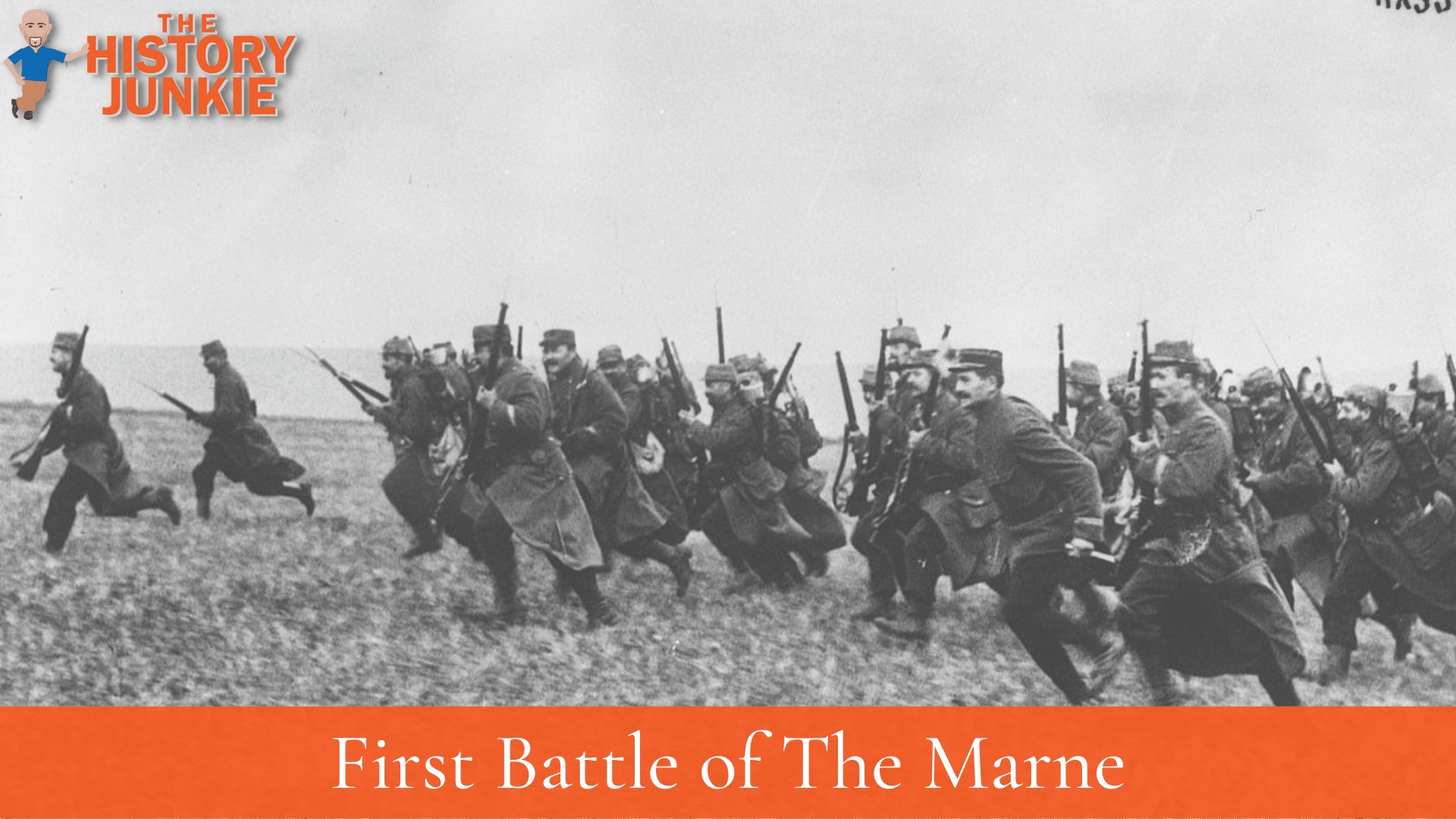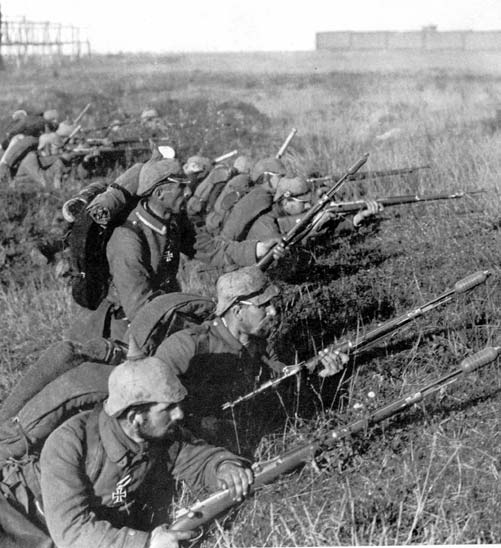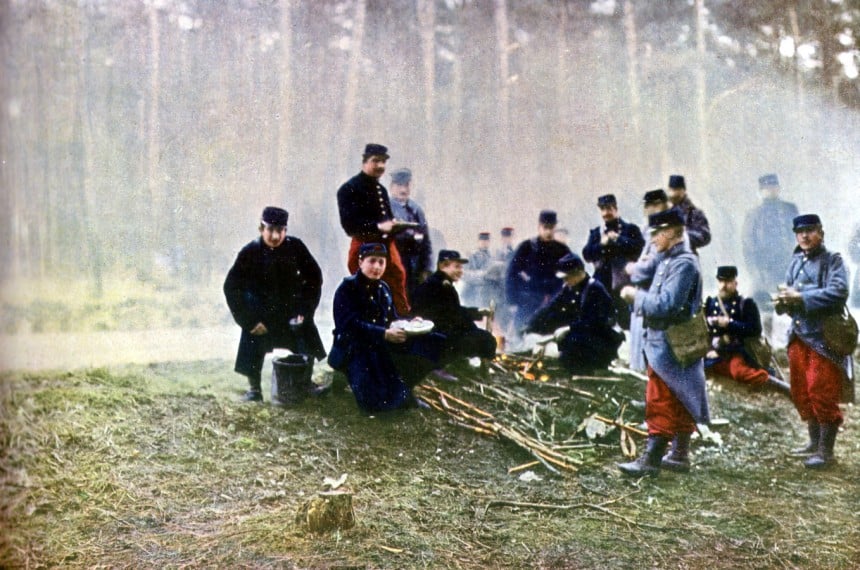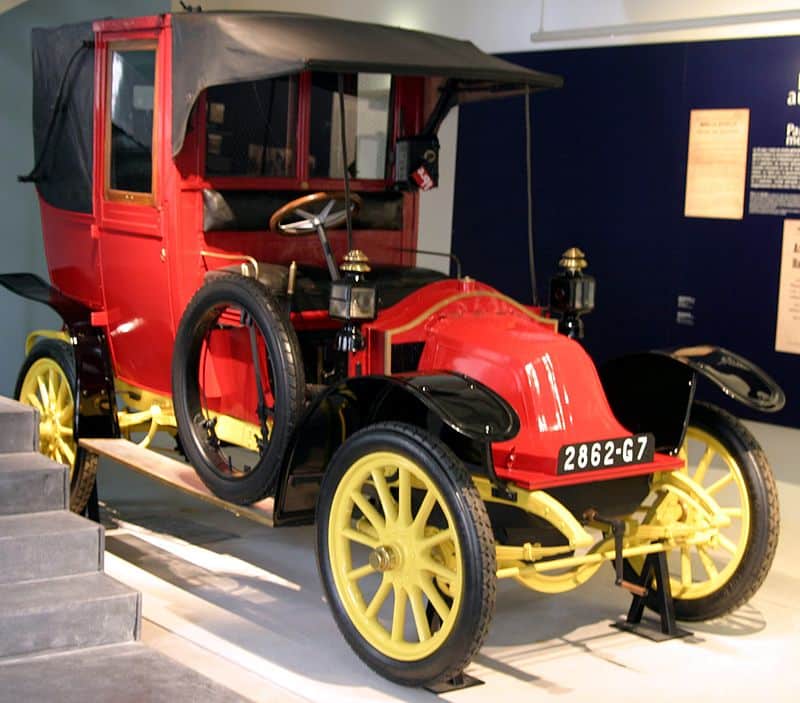The First Battle of the Marne was a battle fought in northeastern France from September 6–12, 1914, as part of World War I.

It was waged between the French and the British Expeditionary Force on the one side and the armies of the German Empire on the other, chiefly along the Marne River, from which it takes its name.
The battle developed as the Franco-British forces attempted to stop the German offensive sweeping through Belgium and into France, aimed at capturing Paris and enveloping the bulk of the French army, in accordance with the Schlieffen Plan, which might then have achieved a quick victory for Germany on the Western Front.
The Battle of the Marne was the bloodiest battle of the war to date on the Western Front, with an estimated 250,000 casualties on each side. It is generally reckoned a victory for the Allies, as they successfully halted the German advance toward Paris and thus thwarted the realization of the Schlieffen Plan.
The German armies retreated after the battle, and their overall commander, General Helmuth von Moltke, is said to have told his sovereign, Kaiser Wilhelm II, "Your Majesty, we have lost the war."
The Allies were unable to follow up their victory by breaking through the German lines, though, and by the end of the year, both sides would have entrenched, beginning the stalemate of trench warfare that would characterize the Western Front for most of the next four years.
Background
Following the assassination of the Austrian Archduke Franz Ferdinand in Sarajevo and the subsequent July Crisis, the major powers of Europe went to war at the end of July and the beginning of August 1914.
Germany, facing a two-front war against Russia in the east and France in the west, had long since decided to resolve the situation via the Schlieffen Plan, which called for a rapid invasion of France from the northeast via neutral Belgium to capture the capital city of Paris, encircle and crush the French armies, and thus quickly knock the country out of the war; it could then throw the bulk of its military against Russia.
In accordance with this plan, German armies crossed into Belgium on August 3, an act that brought Great Britain into the war the following day, as it was a guarantor of Belgian neutrality.
The French, for their part, had committed most of their forces against their direct border with Germany further south in a bid to regain Alsace-Lorraine, which they had lost after the Franco-Prussian War of 1870–71.
This left them, especially at risk of being enveloped from the north and west. However, stiff resistance from the small Belgian army significantly slowed the German advance, giving the Allies time to marshal their resources and regroup.
Battle of the Frontiers
Despite the mounting evidence of the Germans' intention to outflank them, the French armies, under the leadership of General Joseph Joffre, for some time continued their eastward offensive into Alsace-Lorraine, with accompanying thrusts northeastward into the Ardennes region.
Attacks around Metz, Mulhouse, and Lorraine had been decisively stopped by German defenders by August 20, however, and the offensive into the Ardennes was even more bloodily halted.
By August 24, the same day on which soldiers of the German 1st Army crossed from Belgium into France, it was recognized at Joffre's headquarters that these attacks, collectively known as the "Battle of the Frontiers," had failed and that the five French armies were in danger of being cut off from Paris by the larger German offensive.
Only the British Expeditionary Force (BEF) under Sir John French, then only about 70,000 strong and part of the French 5th Army, stood in its way.
The Great Retreat
On August 24, Joffre issued orders canceling the French offensives; instead, the 1st, 2nd, and 3rd Armies were to conduct a fighting retreat westward, while the 4th and 5th (soon joined by a new army, the 6th, formed out of detachments from other units) supported the BEF in blunting the German advance between Lille and Sedan.
General Order No. 2, issued the following day, outlined plans for a defensive stance along the Somme River between Paris and the existing front line.
The military governor of Paris, General Joseph Gallieni, made plans for a close-up defense of the capital, though there were relatively few available troops to defend it with.
However, the German armies were advancing too rapidly; by the 29th, after heavy losses suffered by the French 5th Army around St. Quentin and the retreat of the BEF from around Compiègne, Joffre was forced to abandon the idea of a stand on the Somme, and ordered a further withdrawal southward, towards the Marne, and entertained the possibility of retreating as far as the Seine river.
By September 1, elements of the German First Army, under General Alexander von Kluck, were only thirty miles from Paris, and there was serious talk of evacuating the capital.
Preparations
Despite the impressive German advances or less in keeping with the timetable laid out by the Schlieffen Plan, the attackers' situation was more delicate than it appeared.
Troops had been detached east to reinforce efforts against the Russians, while others had been committed to the Alsace-Lorraine front due to Moltke's belief that he could achieve a breakthrough around Nancy and then attempt a great double envelopment.
As a result, the five German armies advancing through northeastern France were significantly weaker than originally envisioned.
The practical effect of this was that the German line was increasingly thin, with sizable gaps between some of its units.
To close up these gaps, and in the belief that the core of the French army was retreating to the southeast, von Kluck had already, on August 31, begun angling his First Army in that same direction, towards the Marne, rather than swinging west of Paris as earlier planned.
However, the Allied forces, though still retreating, were not as disorganized as the German high command assumed, and Kluck faced stiff resistance from the BEF in particular over the next several days.
In the process, his right flank became exposed from the direction of Paris, now to his west, where Gallieni was building up the new 6th Army, to which the city's garrison forces were added.
Learning of the changed tactical situation on September 3, Gallieni at once urged Joffre to permit an immediate flank attack upon the Germans, which Joffre personally favored but was unwilling to undertake without the active participation of the BEF.
The British and French armies were separate commands, and Sir John French, the BEF's commander, was not only on poor terms with Joffre and his other counterparts but had become increasingly pessimistic in the past weeks of fighting and seemed to prefer a retreat back to Britain altogether.
After receiving what he understood as assurances from BEF headquarters that the British would join in a counterattack, though, Joffre, on the evening of the 4th, issued orders for an attack by his left wing on September 6.
The French 5th and 6th Armies, together with the BEF, would attack Kluck's First Army, now astride the Marne river east of Château-Thierry, with the 3rd and 4th Armies engaging in a frontal attack against the German lines farther east.
French had not, in fact, committed the BEF to Joffre's counterattack, and in fact, that same evening indicated his plans to resume his retreat back toward Fontainebleau.
Joffre was forced to travel to French's headquarters at Melun on the 5th and made a personal appeal to the British general, emphatically protesting, "Monsieur le Maréchal, the honor of England is at stake!"
Moved by his words, French reversed himself and promised, "We will do all we possibly can."
By late afternoon, then, Joffre had achieved the necessary conditions for his planned offensive the following morning.
By this time, Moltke had realized his initial plan had misfired and that the Allies were preparing a large-scale counterattack.
Accordingly, he ordered his (westernmost) First and Second Armies to stand on the defensive, while the Third, Fourth, and Fifth stayed on the offensive further east around Verdun to open the way for the envelopment of the French right.
The same day these orders were issued (September 5), though, General Hans von Gronau, commanding the IV Reserve Corps that covered Kluck's western flank, received intelligence of the French 6th Army's advance toward his front as part of Joffre's planned offensive and responded with an immediate attack of his own along the Ourcq, a minor tributary of the Marne.
Gronau's corps successfully held the 6th Army at bay until nightfall, after which it fell back, while Kluck, now alerted of the threat to his flank, began to reorient his army to face this new threat.
Main Battle
What was called "the Battle of the Marne" was, in fact, two general actions fought more or less simultaneously along the Marne and its tributaries, peaking between September 6 and 9.

Battle of the Ourcq
Though Kluck's right wheel had successfully prevented a flank attack by the 6th Army, he had, in the process, weakened his main front, facing south near the town of Coulommiers, and opened a significant gap (as wide as thirty miles) with neighboring Second Army (under General Karl von Bülow), which in turn was shifting its troops further east, thinning the lines even more.
This sector was among those already earmarked for attack by Joffre, who, on September 6, sent the 5th Army and the BEF forward against the lines held by Kluck and Bülow.
Though the British, who had a long distance to cover after their earlier retreat and made a slower march, were delayed in joining the fight, they had, by day's end, succeeded in crossing the Marne near Rozoy and pushing Kluck's troops back.
The French 5th Army, meanwhile, under General Louis Franchet d'Esperey, brought heavy pressure to bear on Bülow's army around the Grand Morin and Petit Morin rivers.
While Allied progress was less than hoped (for which d'Esperey blamed the British high command), Bülow had taken alarm at the sharp action on his front and, on September 7, began to withdraw behind the Petit Morin, thus widening the gap with Kluck and clearing the way for a mass Allied advance to and across the Marne.

For his part, Kluck and the French 6th Army under Michel-Joseph Maunoury had been trading attacks and counterattacks over the past two days, and as more of the German troops were in battle-ready condition, they more generally held the initiative.
For a time on the 7th, Kluck's army, in fact, threatened a breakthrough, but the French lines held, thanks in part to the arrival of reinforcements from the Paris garrison who were transported to the battlefield by the city's taxis: an event memorialized as the taxis de la Marne.
Despite these and other reinforcements, as late as the evening of September 8, Kluck believed he could envelop Maunoury's flank and retrieve the broader situation; however, that same day, d'Esperey's 5th Army had resumed its assaults on Bülow's front, leaving the German formations still at risk of being isolated and destroyed piecemeal.

Battle of the Marshes
Simultaneous with the fighting along the Ourcq and Morin fronts, the French 4th Army (under General Fernand de Langle) and new 9th Army (under General Ferdinand Foch) attacked the German Third Army (along with the left flank of Bülow's Second Army) further east, around the Marshes of the St. Gond, which were also the headwaters of the Petit Morin, near Châlons-sur-Marne.
Though the operation was originally somewhat limited in intention, with the purpose of guarding d'Esperey's right flank against a counterattack, the offensive-minded Foch expanded it significantly, sending several divisions around the western end of the mostly impassable marshes to flank the Third Army out of its position.
Foch's attack made only slow progress during September 6–7, as his troops' advance was hotly contested by the German defenders, while action elsewhere along the line was limited to long-range artillery duels across the marshes.
By the night of the 7th, though, General Max von Hausen, commanding the Third Army, had decided upon a night attack, which he believed the French would not be expecting.
In the predawn hours of September 8, he sent four divisions forward along the few accessible routes through the marshes, taking Foch's troops by surprise and pushing them back as much as three miles in places.
Despite the shock and the near-breaking of his lines, though, Foch refused to panic or to yield the initiative to Hausen.
With the German advance still in progress, he drafted a message to send to Joffre's headquarters, reading, "My center is giving way, my right is in retreat, situation excellent. I attack."
Though it was probably never sent, the words added to Foch's reputation as a fighter, and during the following day, with reinforcements sent from d'Esperey, he was able to stabilize his front and, indeed, even launch a small counterattack.
By the afternoon of September 9, then, the Battle of the Marshes had ended in, at worst, a stalemate for the French, though the issue further west was still in doubt.
Withdrawal
From the time the Battle of the Marne opened, Moltke had been relatively out of touch with his army commanders; Kluck and Bülow received no orders from him at all on September 6 or 7th despite the importance of their position.
This was due partly to the German high command's habit of allowing its army commanders relative latitude in their operations and partly to the great distance between Moltke's headquarters (in Luxembourg) and the actual front, almost 150 miles away.
In light of this, Moltke sent one of his intelligence officers, Lieutenant Colonel Richard Hentsch, to visit the headquarters of the five attacking German armies and determine the overall situation.
Over the course of September 8, Hentsch, moving from east to west, visited, in turn, the headquarters of the Fifth, Fourth, Third, and Second Armies.
Though the first three were, he judged, in fair condition, Bülow told Hentsch that evening that the gap between his and Kluck's lines had made their position untenable and that they ought to withdraw north of the Marne to avoid being outflanked and overwhelmed.
By the following morning, Hentsch had come to agree with Bülow and his staffers and, visiting Kluck later that day, advised him to disengage and withdraw north in order to close ranks with the rest of the German line.
Though Kluck was initially opposed to this policy-his, IX Corps had already begun to overlap the French northern flank and threatened to sweep into their rear-Bülow had already begun his retreat, and by mid-afternoon, Kluck had instructed his corps commanders to follow suit.
The withdrawal of the First and Second Armies forced Hausen's Third to follow suit, which spurred the other German formations to fall back as well.
After Moltke himself visited the front line on September 11, he ordered all the armies to retreat as far as the Aisne River, some 40–50 miles behind the Marne, and to entrench along the high ground there.
It was around this time that Moltke supposedly told Kaiser Wilhelm, who was at the Supreme Headquarters in Luxembourg, "Your Majesty, we have lost the war."
Whether Moltke actually said this or not is uncertain; but he did seem to understand that German forces had suffered a defeat and would have to abandon the offensive.
Already in poor health when the war started, he also suffered something akin to a nervous breakdown, and on September 14 was relieved of his command, replaced as Chief of the General Staff (the official title for the overall German military commander) by General Erich von Falkenhayn.
Aftermath
Casualties
The week of fighting along the Marne was very bloody on both sides. Exact figures are difficult to determine, as many units reported casualties for extended periods of time that included the Marne as well as other actions.
The traditional estimates are about 500,000 killed, wounded, captured, or missing for all armies, with about 250,000 German casualties, a similar number among the French, and an additional 13,000 British casualties.
More recent analyses have disputed these numbers, suggesting that the actual toll was closer to 300,000.
It has also been remarked that since the action along the Marne was both preceded and followed by heavy fighting, isolating the cost of that battle alone is of questionable value.
Stalemate
On September 10, after the German withdrawal towards the Aisne had been detected by aerial reconnaissance, Joffre ordered a pursuit.
It was relatively slow, however, covering only about a dozen miles a day, and the Germans had time to reach the high ground along the Aisne and establish fortified defensive positions, from which they repulsed French and British attacks from September 14–16. This initiated the so-called "Race to the Sea," as both the Allied and the German armies sought to gain a tactical advantage by turning each other's flank.
As a result, both sides' lines extended farther and farther in both directions until, by late October, they had each run out of room to maneuver, blocked by the North Sea to the northwest and the border with neutral Switzerland to the southeast.
By year's end, therefore, with only frontal assaults (and defending against said assaults) still possible, the Western Front had settled into the "trench warfare" that would characterize it until 1918.
Significance
Most historians agree that the Marne was a significant Allied victory.
By frustrating the Schlieffen Plan and forcing the Germans to retreat and go on the defensive, it ruined the hopes of a quick, decisive defeat of France and the conversion of a two-front war to a one-front war (upon which Kaiser Wilhelm and the German high command had pinned their hopes).
Fighting a protracted two-front war, in which Britain and its powerful navy were now active combatants, made it likely that Germany would eventually lose. Richard Brooks, therefore, dubbed it "the decisive battle of the war, and perhaps of the century."
However, the Marne was also, as Barbara Tuchman called it, an "incomplete victory."
The Allies could not deliver a crippling blow to the German army or drive it from its strong defensive positions after the battle, leaving it in possession of a great deal of French and Belgian territory, including vital factories and iron-ore deposits that would enable it to continue the war effort much longer than it might otherwise have done.
Likewise, the failure to find an alternative to frontal assaults paved the way for the extremely costly trench warfare of the years to come.
The First Battle of the Marne is also distinguished as a sign of the changing nature of warfare and military technology.
The most commonly noted feature of this is the use of the Paris taxicabs to shuttle soldiers to the front at the height of the battle.
Though some historians have downplayed their overall significance, as most troops reached the battlefield by other means, the story was very popular with the public as a patriotic act, and they do represent one of the first instances of motorized infantry.
The Marne was also the first battle in which aircraft played a significant role (chiefly on the Allied side), not so much through firepower but through reconnaissance, as they were able to gather substantial information on enemy troop movements.
